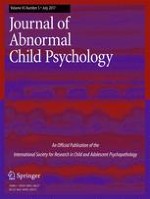14-09-2016
Co-Rumination Exacerbates Stress Generation among Adolescents with Depressive Symptoms
Gepubliceerd in: Research on Child and Adolescent Psychopathology | Uitgave 5/2017
Log in om toegang te krijgenAbstract
Through stress generation, individuals’ own thoughts and behaviors can actually lead to increases in their experience of stress. Unfortunately, stress generation is especially common among individuals who are already suffering from elevated depressive symptoms. However, despite the acknowledgement that some individuals with depressive symptoms generate greater stress than others, few studies have identified specific factors that could exacerbate stress generation among individuals with depressive symptoms. The present study examines co-rumination as a factor that might exacerbate stress generation among adolescents with depressive symptoms using a short-term longitudinal design. Considering these processes among adolescents was critical given that many youth experience increases in depressive symptoms at this developmental stage and that co-rumination also becomes more common at adolescence. Participants were 628 adolescents (326 girls; 302 boys) who reported on their depressive symptoms, experiences of stress, and co-rumination with a best friend. Interpersonal stressors (peer and family stress) and non-interpersonal stressors (school and sports stress) were assessed. Consistent with past research, adolescents with depressive symptoms experienced greater interpersonal and non-interpersonal stress over time. Importantly, co-rumination interacted with both depressive symptoms and gender in predicting increases in peer stress. Depressive symptoms predicted the generation of peer stress only for girls who reported high levels of co-rumination with friends. Implications for protecting youth with depressive symptoms against stress generation are discussed.
